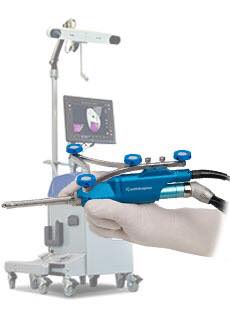
CONTRIBUTED CONTENT — It’s a win-win situation for professionals and patients alike now that orthopaedic surgeons in St. George have a new assistant at the operating table that helps guarantee great outcomes for knee-replacement patients every time.
St. George Surgical Center, a physician-owned and operated multispecialty outpatient facility, is the first ambulatory surgery center in Utah to exclusively offer patients the NAVIO robotic-assisted surgical system — the next generation of total knee-replacement surgery.
“This is big news for Southern Utah,” said St. George Surgical Center CEO and administrator Ty Tippets. “Healing time is quicker, incisions are smaller — there are a lot of benefits. (NAVIO) is for individuals that want to stay active but whose knees are worn out.”
The NAVIO robotic-assisted surgical system is a state-of-the-art technology that offers great opportunities for individuals wondering if knee-replacement surgery is the right decision. For those with questions, orthopaedic surgeon and total joint specialist Dr. Michael Manning of Novatio said the procedure provides a level of accuracy that cannot be duplicated by a human. In fact, their first patient waited an entire year for the system to arrive because of its precision.
Manning told St. George News that the patient’s knee needed to be replaced for well over 10 years, and despite being a truly complex surgery, the patient ended up walking out of the surgical center in the end.

The NAVIO robotic-assisted surgical system uses an advanced computer system and a series of sensors on a servomechanism that gather precise patient measurements. The system uses the data to create an individual surgical plan and may eliminate the need for preoperative imaging. It also helps surgeons to determine the exact placement of incisions and implants, allowing them to work according to very precise standards.
Manning has been evaluating different computer-assisted systems for the past five years and said NAVIO has the “most robust platform.”
“You want to gather as much data as possible,” he said.
After applying sensors to the patient, surgeons use a handheld device to create three-dimensional and two-dimensional representations of the patient’s femur and tibia, he said. This “surveying” of the area allows them to make refinements in the surgical plan and know exactly where to make cuts even before picking up a scalpel.
Surgeons then use the system to prepare the bone to the correct size and position for implants. In order to prevent more of the bone being removed than necessary, the robot’s servomechanism retracts when the desired point is reached.
Tippets said this means surgeons are able to plan things better.
NAVIO can be used for partial knee replacements, kneecap or patella femoral replacements and total knee replacements, preserving the cruciate ligaments in certain cases. It is the only system that allows for that, Manning said.
The procedure is most successful in active adults who have developed knee problems and have opted out of surgery in the past. It is also extremely durable. NAVIO implants have been approved by the Food and Drug Administration to be marketed to last 30 years.
“This is another tool in the toolbox,” Manning said.
However, having done more than 1,000 knee and hip replacements through his practice over nine years, he said there are times when it is appropriate to use technology and times when you should pause and say, “That just doesn’t look right.” It is important to have experienced hands behind any machine, he said.
“It’s kind of like a backup camera in the car,” he said. “If you’re just reliant on the backup camera, you’re going to have some problems. … You’re going to end up running into something because there are things that are out of your field of view. This is kind of like that. Is it good technology? Yes, it is good technology. Should you rely 100% on it? I don’t think so.”
Manning said his role is primarily to educate patients, to align their expectations with the reality of the procedure. It takes time, but he never just treats an X-ray.
“It’s teaching them essentially what to expect and what needs to be done to get them there,” he said.
Manning said the real reward is when he can help someone. Recently, he had an 82-year-old wheelchair-bound woman who came into his office complaining of excruciating pain, and he thought, “Wow, am I really going to be able to help her?” Four weeks later, she returned walking, saying she was very grateful and felt amazing.
“That’s the payment – she’s not in a wheelchair,” he said. “If I could do what I do for free, I would do it in a heartbeat.”
For more information about the NAVIO robotic-assisted surgery, visit the St. George Surgical Center website. To schedule a consultation with a NAVIO-certified orthopaedic surgeon to see if you’re a candidate, call the center today at 844-673-0095.
Written by ANDREW PINCKNEY, St. George News.
• S P O N S O R E D C O N T E N T •
Resources
- St. George Surgical Center | Address: 676 S. Bluff St., St. George | Telephone: 435-673-0095, 844-673-0095 | Website | Facebook.
Email: [email protected]
Twitter: @STGnews
Copyright St. George News, SaintGeorgeUtah.com LLC, 2020, all rights reserved.